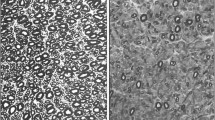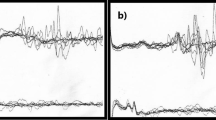Summary
The electrically and optically elicited orbicularis oculi reflex (OOR) and facial nerve latency were investigated in eight patients from three families. Each had autosomal dominant peroneal muscular atrophy. In a family with the dominantly inherited hypertrophic type markedly delayed latencies of the early reflex component of the OOR were found while the facial nerve had remained unaffected. These findings were interpreted as an indicator for supraorbital nerve involvement. In the other two investigated families of hypertrophic and neuronal type, a prolonged facial nerve latency was demonstrable. In these cases the latency of the optically evoked blink reflex was also delayed, while the latency of the early reflex component of the OOR was within normal limits or only slightly delayed. It is assumed that the different degree of cranial nerve involvement in these families is the expression of their genetically determined peculiarities.
Zusammenfassung
An acht Patienten aus drei Familien mit autosomaldominant vererbter peronealer Muskelatrophie wurde der elektrisch und optisch evozierte Orbicularis oculi-Reflex (OOR) sowie die distale Latenzzeit des N. facialis geprüft. Dabei fand sich in einer Familie mit dominant vererbter hyertrophischer Form (Typ 1 nach Dyck) eine deutliche Latenzzeitverlängerung der frühen Reflexkomponente des OOR bei intaktem N. facialis. Dieser Befund wird als Zeichen einer Trigeminusbeteiligung (N. supraorbitalis) gedeutet. Bei den anderen Familien (hypertrophischer und neuronaler Typ) ließ sich eine verlängerte distale Latenzzeit des N. facialis nachweisen. In diesen Fällen war zugleich die Latenzzeit des optisch evozierten OOR verlängert, während die Latenzzeit der frühen Komponente des elektrisch ausgelösten OOR nur geringfügig verlängert oder im Normbereich war. Es wird zur Diskussion gestellt, daß die unterschiedliche Hirnnervenbeteiligung Ausdruck genetisch fixierter Besonderheiten in den einzelnen Familien ist. Nach den hier gewonnenen Ergebnissen könnte eine Hirnnervenbeteiligung bei peronealer Muskelatrophie häufiger sein als bisher angenommen wurde.
Similar content being viewed by others
References
Becker PE (1966) Krankheiten mit hauptsächlicher Beteiligung der peripheren Nerven und spinalen Wurzeln. In: Becker PE (ed) Humangenetik, Bd V/1. Thieme, Stuttgart, pp 411–440
Behse F, Buchthal F (1977) Peroneal muscular atrophy (PMA) and related disorders. II: Histological findings in sural nerves. Brain 100:67–85
Brust JCM, Lovelace RE, Devi S (1979) Clinical and electrodiagnostic features of Charcot-Marie-Tooth disease plus additional neurological features. In: Serratrice G, Roux H (eds) Peroneal atrophies and related disorders. Masson Publishing USA, pp 39–47
Buchthal F, Behse F (1977) Peroneal muscular atrophy (PMA) and related disorders. I: Clinical manifestations as related to biopsy findings, nerve conduction and electromyography. Brain 100:41–66
Dyck PJ (1975) Inherited neuronal degeneration and atrophy affecting peripheral motor, sensory and autonomic neurons. In: Dyck PJ, Thomas PK, Lambert EH (eds) Peripheral neuropathy, vol II. W. B. Saunders, Philadelphia, pp 825–867
Kimura J (1971) An evaluation of the facial and trigeminal nerves in polyneuropathy: electrodiagnostic study in Charcot-Marie-Tooth disease, Guillain-Barré syndrome, and diabetic neuropathy. Neurology 21:745–752
Kimura J, Rodnitzky RL, van Allen MW (1970) Electrodiagnostic study of trigeminal nerve. Neurology 20:574–583
Krott HM, Poremba M, Busse M (1969) Latenzmessungen am N. facialis beim Acusticusneurinom. Dtsch Z Nervenheilk 195:344–355
Lovelace RE, Brust JCM, Devi S (1979) Clinical and electrodiagnostic features of typical Charcot-Marie-Tooth disease. In: Serratrice G, Roux H (eds) Peroneal atrophies and related disorders. Masson Publishing USA, pp 23–37
Miller DW, Nelson JA, Bender LF (1970) Measurement of latency in facial nerve in normal and uremic persons. Arch Phys Med 51:413–417
de Recondo J (1975) Hereditary neurogenic muscular atrophies (Charcot-Marie-Tooth disease). In: Vinken PJ, Bruyn GW (eds) Handbook of clinical neurology, vol 21/part I. North-Holland Publishing Company, Amsterdam, pp 271 ff.
Rosenberg RN, Chutorian A (1967) Familial opticoacoustic nerve degeneration and polyneuropathy. Neurology 17:827–832
Satya-Murti S, Cacace AT, Hanson PA (1979) Abnormal auditory evoked potentials in hereditary motor-sensory neuropathy. Ann Neurol 5:445–448
Strenge H (1980) The blink reflex in chronic renal failure. J Neurol 222:205–214
Struppler A, Dobbelstein H (1963) Elektromyographische Untersuchung des Glabella-Reflexes bei verschiedenen neurologischen Störungen. Nervenarzt 34:347–352
Tackmann W, Radü EW (1980) Pattern shift visual evoked potentials in Charcot-Marie-Tooth disease, HMSN type 1. J Neurol 224:71–74
Taverner D (1965) Electrodiagnosis in facial palsy. Arch Otolaryng 81:470–477
Taverner D, Langworth EP (1963) The prognosis in facial palsy. Brain 86:465–480
Author information
Authors and Affiliations
Rights and permissions
About this article
Cite this article
Malin, JP. Trigeminal and facial nerve involvement in charcot-marie-tooth disease. J Neurol 226, 101–109 (1981). https://doi.org/10.1007/BF00313437
Received:
Issue Date:
DOI: https://doi.org/10.1007/BF00313437




